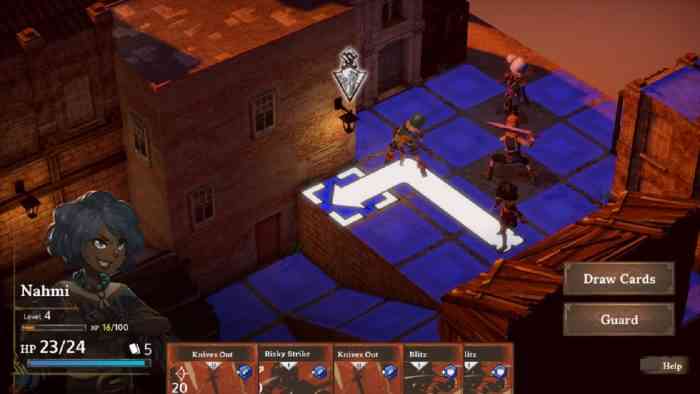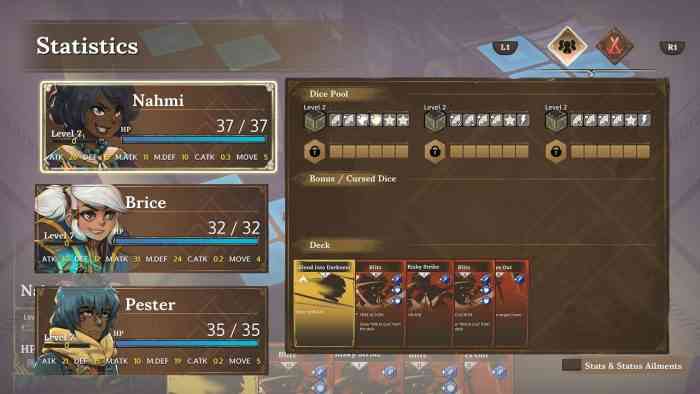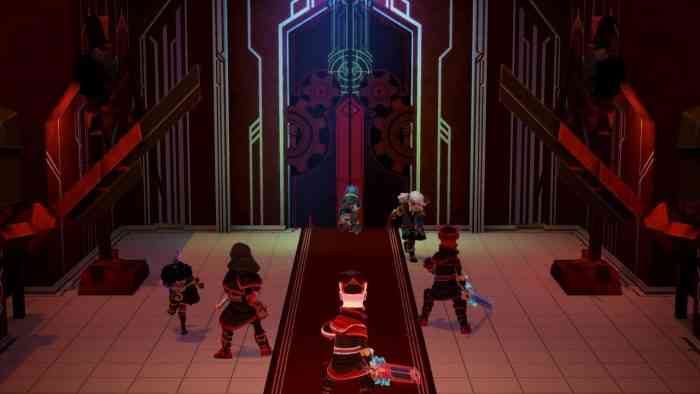At the End of Launch Week with Cardboard Utopia’s Andrée Boutin
Having dropped earlier this week for PS4 and Steam, Cardboard Utopia’s Children of Zodiarcs deserves to be on your radar for its refreshing take on SRPG genre. As huge fans of tabletop RPGs, the indie studio based in Montreal sought to implement a touch of dice rolling and card deck-building to shake things up for the traditional grid-based combat. On top of that, the game is one of the latest releases under the Square Enix Collective. At the tail end of their launch week, I was able to chat over email with the team’s Andrée Boutin to learn more about the studio’s first game.
How has the last month before launch been for your team?
Pretty intense, as you might guess, but not for the reasons people usually believe! During the last month before launch, production was pretty much done. There was the process of testing and debugging of course, doing a little bit of polish, etc., but really, so close to release, most of our time is focused on marketing, planning the launch itself. Despite several of us at the studio having experience in the videogame industry and having shipped many games, we were pretty new to publishing a game, and had to learn a lot while putting in all the work needed to get the launch ready.
Your game had a base version that was funded, but you came to Kickstarter to add more content and involve the community. How has the community been for the game during its development phase? Did that second dice roll idea come from the community?
The community has been really amazing. We received so much support, our fans have been so nice, patient, and helpful. One of our goals with the Kickstarter campaign was to build a bigger, solid community, and we are super happy with the outcome. It’s been great discussing with people in the comments of the campaign, meeting backers at show, etc.
Although they did give us some great and valuable feedback, especially during the beta phase, the second dice roll didn’t come directly from the community. During the summer and fall of 2015, we did some intense prototyping of the gameplay systems, we threw all our ideas on a board, and playtested almost all of them week after week, to find the right combination of features. The second dice rolls was one of these ideas. When we playtested it (with the great people of the Montreal indie dev and fan community), we felt that this was the mechanic that brought the synergy between the cards and dice together. It allowed for a greater sense of agency, and added so much to the strategy.
With TRPG as one of the game’s main influences, is there actually any plans for a tabletop version of the game?
Not at this point, no. We actually wanted to ensure that although Children of Zodiarcs absolutely integrates elements of tabletops, it would still genuinely be a videogame at its core, and not a videogame version of a tabletop. This is why some parts of the game would be difficult to translate into a physical/tabletop form without losing some of its essence, like the leveling up of the cards, the dice crafting, and, most of all, the story.
Compared to other SRPGs, it would appear like Children of Zodiarcs is more character-driven. Is that fair to say?
SRPGs are pretty known for their characters and the relationship the fans build to them, so it’s difficult to confidently assert that Children of Zodiarcs is specifically more character-driven than the classics of the genre. However, while we tried to pay homage to the classic style of story telling you usually find in SRPGs, we definitely tried to take our own path in some ways; we focused on a much more personal story, stepped away from the more traditional “young, pure-hearted hero saves the world” plot to tell a more complex story of survival and personal conflict regarding the morality vs the necessity of one’s own actions. That did mean to spend a bit more time trying to establish a relationship between the player and the characters rather than the action itself, and trying to develop interesting, varied and complex characters that evolve as the story progresses.
SRPGs usually have morally-grey villains and heroes, what can players expect from the Toran Empire?
At first glance, the Torans are the typical villains, hell bent on eliminating the heroes, which they deem lesser and to which they attribute little to no humanity. The Torans are an oppressive force. They conquer and dominate other people as much as their own, like the poor people of The Shambles. This is why in their case, we actually voluntarily hid their eyes under a helmet or behind a mask, to make them feel more like this impressive and oppressive monolith.
However, as for many characters in the game, the motivations and the values of the Toran Empire’s Nobles and Guard will be explored and questioned throughout the game, mostly through the character of Argon, Master of the Guard, who has a significant role. The fact that some Torans also have their whole face visible since they were designed in the likeness of some of our Kickstarter backers, and that some Torans will have something to say during the Arena of Xin’s battles about how they’re being treated by the heroes also help humanizing them. All these devices allowed us to make the game and the story start in a relatively traditional matter, to then later start reflecting upon their position as the “hero” of the story.

Tell me about your favorite track in the game?
That is a very tough question because the tracks are so good, it’s really hard to choose! Frankly, I have been in love with the Main Title ever since I heard the fully orchestrated version. I remember hearing it after it was implemented in the game. I booted the game up to do some testing, and it started playing while I was on the Title screen. I just sat there, not pressing any button, just listening to it! It instantaneously captivated me. So awesome, epic and moving at the same time, so rich. Just a perfect song for a JRPG-style game.
Alternatively, I also like Pester’s Theme, and Facing the Ghosts and In the Depths of Consciousness (the Arena of Xin’s themes) because they are so creative and support the characters and ambiance so well. But in the end, which track I love the most also really depends on my mood, as there’s everything on the soundtrack: quirky, uplifting tunes, heavy dramatic ones, epic, mysterious, or touching ones, etc.!
One of the things I loved about playing SRPGs was going to new shops and kitting my units to get stronger or changing classes. With no traditional equipment, inventory, or class-changing, your game handles character progression differently through card upgrades and new dice. It’s a refreshing take on the genre! What are some ways that an end-game Brice could wreck the first stage?
Brice is an interesting one to see evolve because as a mage with a powerful Zodiarc gauntlet, I find her pretty satisfying to play from the start! I love her heavy damage attacks, especially the ones that affect multiple enemies. But as the game progresses, these attacks will get more powerful, and come with all sorts of curses (enemies will discard cards, bleed for 3 turns, etc.). That’s one of the fun things with the cards in Children of Zodiarcs: since they level up, the ones you have at the beginning of the game don’t become obsolete as you unlock new ones; you can take full advantage of your whole deck throughout the entire game.
So by the end of the game, Brice has a healthy selection of pretty powerful magical attacks and curse cards to choose from, and it’s beautiful to see all the damage she leaves in her wake, especially when her level is high!
Similarly, do the characters have cards that are exclusive to them?
All the cards are exclusive to the character who holds them. The heroes may share types of cards (physical attacks, magical attacks, support or healing abilities, curses), but the specific ability each unique card represents is unique to a character. This makes deck building interesting as it is done considering the cards one given character has access to, but also by taking into account the cards other characters have in their deck!
What can players expect, in terms of replayability?
Although Children of Zodiarcs’ story won’t change on a second playthrough, the gameplay allows for an interesting level of replayability, thanks to the customization mechanics and the two difficulty modes. Some players have already mentioned that they’re looking forward to play the game a second time to try out new decks and to craft new dice for their heroes, to try out a new play style! The difference between normal and hard mode also makes it possible to re-experience the game differently: normal mode allows the player to level-up their characters way above the level of the enemies, if they want, and to deal satisfyingly powerful blows to the bad guys. However, in hard mode, the enemies will always stay one level above that of the player’s characters, which means that the only way to win will be to use one’s tactical skills and tools, instead of relying on brute force. It’s an interesting challenge for those who really want a playthrough that’s all about strategy!
As an indie studio based in Montreal, can you describe the scene there?
The Montreal indie scene is exceptionally vibrant. We are very lucky to be part of a great, large community of devs who love to share and help each other out. It is also fairly organized, with its own spaces – like Gameplay Space, a coworking space dedicated to indie studios, where we work from, which is also a community hub where plenty of activities happen – with its own events, like the annual DemoNight, and its own structures like La Guilde des développeurs indépendants du Québec [The Quebec Indie Developers’ Guild ], which is an association of indie studios that aims at representing the indie community and provide services for it. There’s also a lot of events and festivals in Montreal were indies are welcome to demo their games (Montréal Joue, Comiccon, Otakuthon, Dreamhack Montreal, the Montreal Independent Game Festival), which helps the local games being known by the public, and a fair amount of support from various private and public organisations which focus on the videogame industry at large, like the Montreal International Game Summit (MIGS), or on start-up development which help the community thrive.

What classic SRPG series would you love to see resurrected (FFT, Tactics Ogre, Shing Force, Front Mission, etc.)?
For this one, I asked the question to our creative director, Jason, and here’s what he said:
“Oh boy. I would LOOOOOOVE to see Shining Force brought back. Shining Force 1 was the first SRPG I ever played, and I instantly fell in love with it. I loved the massive cast of fun and interesting characters, the fact that you brought 12 units into combat, that promoting a character to their new class made it super exciting to try out different ones, and that you felt a real sense of progression as your headquarters gradually filled up with more and more characters as you recruited them throughout the game. That game had gameplay and charm that I hadn’t experienced in a game before. It was magic. Literal magic. Doves and handkerchiefs flew out of my jacket the next day. Magic.
I do sometimes try to imagine what a modern SF would look like, but then I worry that since the games are so old and “traditional”, it would be super hard to modernize them without losing the essence that made the games so great. Thankfully, Fire Emblem Awakening came out and proved that you can stay true to a decade’s old legacy but still comfortably sit in the modern videogame landscape. FEA rejuvenated my desire to see a new, modern SF game. If you’re friends with Sega, tell them to get on it!”
What do you want Cardboard Utopia to be known for?
Cardboard Utopia was started with the goal of making memorable games. We hope that years after you’ve finished playing one of our games and put it away, you’ll see something that reminds you of that game and get struck by nostalgia, run to your attic to find that old cartr… I mean that old .exe and try to have it run on whatever computer will be installed directly into your brain (because you know, it will be the future).
Jokes aside, we want players to think of the games made by Cardboard Utopia and remember the characters they fell in love with, the dozens of hours upon hours they spent with these games as they explored the hidden depths of their gameplay, and the communities they became a part of as they discussed different narrative theories and gameplay strategies with other fans. We hope that after we’ve shipped a few games, we’ll have earned a reputation of developing games that you still think about after you’ve stepped away from the screen. That the time you spend playing one of our games is time spent that you will cherish.
Children of Zodiarcs released for Steam and PS4 on July 18, 2017.
The interview has been lightly edited for clarity and brevity.